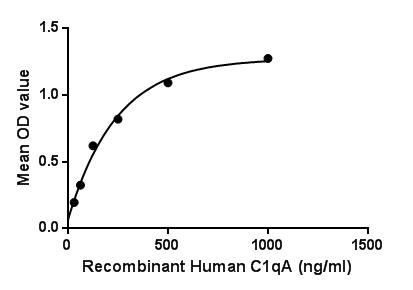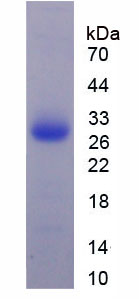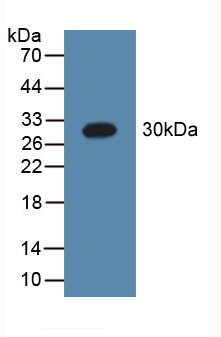
Details
ACTIVITY TEST
Buffer Formulation 20mM Tris, 150mM NaCl, pH8.0, containing 1mM EDTA, 1mM DTT, 0.01% SKL, 5% Trehalose and Proclin300. Traits Freeze-dried powder Purity > 95% Isoelectric Point 9.6 Applications Cell culture; Activity Assays.

Figure. The binding activity of C1qA with CRP.
The complement component 1q (C1q) is composed of 18 polypeptide chains: six A-chains, six B-chains, and six C-chains. Complement Component 1, Q Subcomponent A (C1qA) is six A-chains of C1q. Complement component 1q (C1q is a protein complex involved in the complement system, which is part of the innate immune system. C1q together with C1r and C1s form the C1 complex. It is potentially multivalent for attachment to the complement fixation sites of immunoglobulin. The sites are on the CH2 domain of IgG and, it is thought, on the CH4 domain of IgM. IgG4 cannot bind C1q, but the other three IgG types can. Besides, C Reactive Protein (CRP) has been identified as an interactor of C1qA, thus a binding ELISA assay was conducted to detect the interaction of recombinant human C1qA and recombinant human CRP. Briefly, C1qA were diluted serially in PBS, with 0.01% BSA (pH 7.4). Duplicate samples of 100μL were then transferred to CRP-coated microtiter wells and incubated for 2h at 37℃. Wells were washed with PBST and incubated for 1h with anti-C1qA pAb, then aspirated and washed 3 times. After incubation with HRP labelled secondary antibody, wells were aspirated and washed 3 times. With the addition of substrate solution, wells were incubated 15-25 minutes at 37℃. Finally, add 50µL stop solution to the wells and read at 450nm immediately. The binding activity of C1qA and CRP was shown in Figure 1, and this effect was in a dose dependent manner.USAGE
Reconstitute in 20mM Tris, 150mM NaCl (pH8.0) to a concentration of 0.1-1.0 mg/mL. Do not vortex.
STORAGE
Avoid repeated freeze/thaw cycles. Store at 2-8°C for one month. Aliquot and store at -80°C for 12 months.
STABILITY
The thermal stability is described by the loss rate. The loss rate was determined by accelerated thermal degradation test, that is, incubate the protein at 37°C for 48h, and no obvious degradation and precipitation were observed. The loss rate is less than 5% within the expiration date under appropriate storage condition.
Image

Figure . Gene Sequencing (extract)
Image

Figure. SDS-PAGE

Figure. Western Blot
Partial purchase records(bought amounts latest0)
User Comment(Total0User Comment Num)
- No comment


 +86 571 56623320
+86 571 56623320




